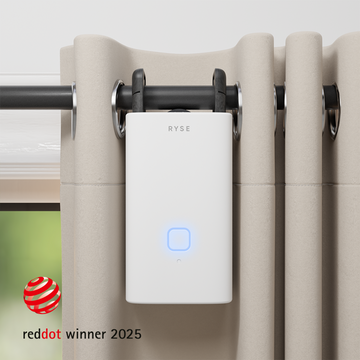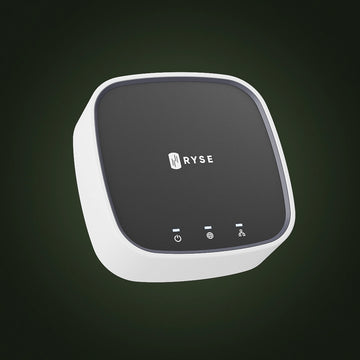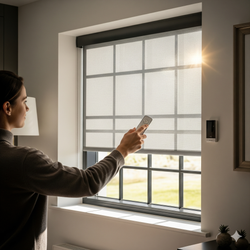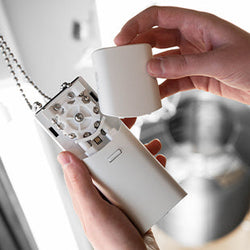What You’ll Learn
- The five key areas where smart technology can enhance comfort, security, and energy savings
- How to approach building a smart home system that fits your space — whether you're renting a condo or living in a full house
- Which smart devices are most impactful (and why)
- How products like smart blinds fit naturally into a smart home ecosystem
- What to consider before investing in a smart device
The Rise of Smart Living
Smart home technology is no longer a futuristic concept or something reserved for luxury homes. It’s become part of how we live — streamlining daily routines, keeping our spaces more secure, and helping us live more comfortably.
From lighting that adjusts based on the time of day to window shades that close themselves at sunset, smart devices allow you to create a home that actively supports your lifestyle. And it doesn’t have to be complicated — or expensive — to get started.
Whether you’re in a one-bedroom rental or a four-bedroom family home, the right setup can make life smoother. Let’s break down what that really means.
The Core Categories of Smart Home Tech
Smart home systems usually serve five major purposes. These categories can help you figure out which devices are worth your investment — and how they work together to create a connected ecosystem.
1. Comfort & Convenience
This is where most people start — with devices that simplify everyday tasks. Think of smart thermostats that adjust to your schedule, lights that dim automatically in the evening, or blinds that open with the sunrise. These features reduce the need for manual adjustments and help you feel more at ease in your space.
2. Safety & Security
Smart cameras, video doorbells, motion sensors, and smart locks all fall under this category. Whether you're at home or away, they give you better awareness of what’s happening — and peace of mind through remote access and notifications.
3. Energy & Efficiency
Energy-conscious devices like smart plugs and thermostats help you cut down on waste and reduce utility bills. Even smart blinds can contribute here by blocking sunlight during peak hours or letting in natural light to reduce artificial lighting use.
4. Entertainment & Media
Multi-room speaker systems, smart TVs, and voice-controlled assistants are all about elevating how you relax, work, or entertain. These systems often act as the control hub for your smart home ecosystem.
5. Health & Wellness
From smart air purifiers to water leak detectors and sleep trackers, these devices focus on your physical environment and well-being. They're becoming increasingly popular in both urban apartments and suburban homes.
Building Smart Home Ecosystems: From Condos to Houses
Not every home needs the same setup — and that’s the beauty of smart tech. Whether you’re working with 400 or 2,000 square feet, your system can scale to fit your lifestyle and space.
In a Condo or Apartment
If you're renting or living in a smaller space, the goal is to keep things simple and wireless. Look for:
-
Plug-and-play or adhesive-based products (no drilling required)
-
Voice control or app control (no hub necessary)
-
Devices that work with your existing Wi-Fi network
Examples: Smart bulbs, smart plugs, portable smart speakers, compact air monitors, and add-on smart blind motors.
In a House
With more space and control over wiring, you can invest in a larger setup:
-
A central hub to integrate all devices
-
Multiple sensors (windows, doors, motion)
-
Zoned climate and lighting control
-
Exterior cameras and garage automation
A smart home system in a house can be more deeply integrated — but still manageable with the right platform (like Google Home, Alexa, or Apple HomeKit).
5 Smart Home Devices That Actually Make a Difference
Here’s a curated list of devices that punch above their weight in usefulness. Whether you're building your setup piece by piece or looking for high-impact upgrades, these belong on your radar:
1. Smart Thermostat
These learn your schedule and preferences, adjusting heating or cooling automatically. They help cut energy costs and keep your space comfortable without constant tweaking.
Why it matters: HVAC systems are among the biggest energy consumers. Smart thermostats reduce waste and keep your bills in check.
2. Smart Plug or Smart Power Strip
A simple way to turn anything into a smart device — from lamps to coffee makers. Schedule devices, monitor energy use, and turn things off remotely.
Why it matters: They’re inexpensive, flexible, and perfect for renters or smart home beginners.
3. Smart Blinds (Like RYSE SmartShade)
Automated window shades may seem like a luxury, but they play a big role in sleep quality, energy efficiency, and even home security. RYSE SmartShade lets you motorize your existing shades — no need to replace them.
Why it matters: Smart blinds help regulate room temperature, block light when needed, and provide privacy on your terms. RYSE stands out for being retrofit-friendly, renter-safe, and compatible with most shade chains.
4. Video Doorbell or Smart Camera
Keep an eye on your entryways, talk to visitors remotely, and get alerts when someone approaches your home — whether you’re there or not.
Why it matters: Visibility and control over your space add peace of mind, especially when you’re not home.
5. Smart Lighting
Set mood-based lighting scenes, mimic your daily rhythm, and enhance security by scheduling lights when you're away.
Why it matters: Lighting affects everything from your circadian rhythm to energy use. Smart lighting is one of the easiest and most noticeable upgrades.
Smarter Living, Room by Room
Smart homes aren’t about flashy tech — they’re about real-world improvements to your everyday routines. Whether you’re living in a studio apartment or a multi-bedroom house, today’s smart devices offer scalable, flexible solutions that:
- Make your home more energy-efficient (think: thermostats and blinds)
- Add layers of safety and control (hello, smart plugs and cameras)
-
Support your comfort and well-being (like better sleep and lighting)
You don’t need to automate everything at once. Start with what impacts your life the most — then build from there. And with retrofit-friendly options like RYSE SmartShade, even renters can step into smarter living.
FAQ
What are the benefits of smart home devices if I rent or live in a small space?
Smart tech is now renter- and condo-friendly. Many devices are wireless, require no drilling, and run on Wi-Fi. You can automate lights, control temperature, and improve sleep without permanent changes to your space.
How does RYSE SmartShade fit into a smart home setup?
RYSE adds smart automation to your existing window shades — no need to buy new ones. It's compatible with most beaded chains and integrates with platforms like Alexa, Google Home, and Apple HomeKit. Ideal for those who want comfort, privacy, and energy savings with minimal effort.
Do I need a hub or central system to make all my devices work together?
Not necessarily. Many smart home products are app-based and work independently. But if you’re planning a larger setup, a hub (like Alexa, Google Home, or HomeKit) can help manage
devices in one place and trigger actions across categories (e.g. “Goodnight” mode that closes blinds, dims lights, and locks doors).
How expensive is it to automate a home — and is it worth it?
Costs vary. A basic setup (smart plug, thermostat) can be under $300. Adding blinds, security, or full-home integration increases that. But the payoff is real: energy savings, convenience, and enhanced safety often justify the investment.
Can smart devices actually make my home safer?
Yes. Smart plugs can prevent overheating of appliances. Cameras and motion sensors alert you to intrusions. Smart blinds like RYSE help keep your routines private from outside view — all manageable remotely from your phone or voice assistant.







